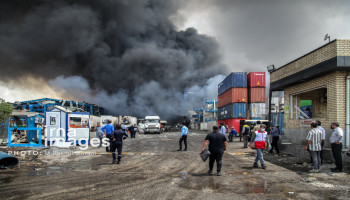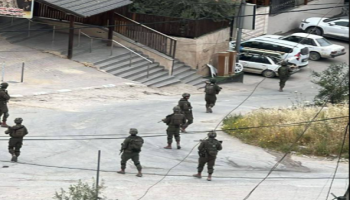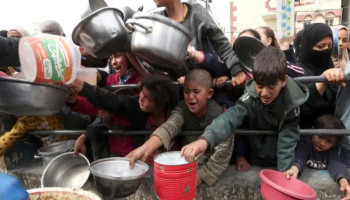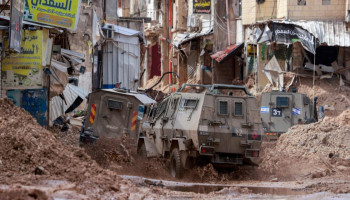Resistance Moves Towards “Haifa for Dahiya” Equation
After overcoming the hurdles of "Israeli" strikes, the field realities have demonstrated that the Islamic Resistance in Lebanon is now firmly establishing the "Haifa for Dahiya" equation. This was officially launched on Tuesday, October 8, 2023, coinciding with the second appearance of Hezbollah's Deputy Secretary-General, Sheikh Naim Qassem. It was marked by the firing of the first batch of 105 rockets that hit targets in Haifa and the Krayot area within less than half an hour.
The "Israelis" understood that Hezbollah now possesses firepower allowing it to shift to a new phase in the confrontation and manage the war. According to media reports directed by the U.S. (Sky News Arabia), Washington seeks to establish the equation of “Haifa for Beirut,” not for Dahiya, leaving Israel free under U.S. approval to accomplish the war's goal: eliminating Hezbollah and rebuilding Lebanon's political system. The first phase aims to secure the capital, Beirut, for the new authority, distancing it from the risks of destruction. However, Hezbollah works towards the “Tel Aviv for Beirut” equation and may escalate towards harsher equations as the party has fully regained its strength.
According to resistance fighters, two drones targeted Herzliya in occupied Yaffa Friday night, one hitting its target and cutting off electricity, while the second was shot down. An "Israeli" interceptor missile caused damage to a building. Though Hezbollah has not yet issued a statement on this operation, it seems to be a response to the Zionist aggression on Thursday night on the Bachoura and Basta Tahta neighborhoods in Beirut, which resulted in numerous civilian casualties.
Based on initial analysis, this operation's significance lies in the distance covered by the drone to reach Herzliya, estimated at about 100 kilometers, this revealed a new type of drone, only discovered over "Tel Aviv." According to some Zionist media reports, the initial assessment was that the drones were not from Lebanon but from Iraq or Yemen, until finalizing that the launch was from Lebanon.
The "Israeli" enemy seems to have made a fundamental mistake when it rushed to evaluate the results of its strikes against Hezbollah’s leadership and weapon depots, assuming the party had lost its ability to rebuild and maintain deterrence equations. Promises were made for settlers to quickly return to the north, with some officials setting near-term dates for the resumption of normal life.
However, as Hezbollah resumed its operations, including repairing its leadership and operational structures, rockets began falling heavily on "Haifa and beyond," reaching the outskirts of occupied Yaffa. Additionally, for the first time, the resistance used new types of rockets, the effects and remnants of which would reveal their nature to the enemy. These were employed to target the 7200 military base early Saturday morning, October 12, located between Haifa and Yaffa. This was preceded by a significant statement from Hezbollah’s operations room on Friday night, in which the resistance inaugurated a new path, warning settlers not to remain near military gathering points within some northern settlements where the enemy gathers its officers and soldiers.
For the first time, the resistance warned settlers to stay away from these military gathering points to preserve their lives, "until further notice." This underscores that the resistance is steadfast in establishing the "Haifa for Dahiya" equation without retreat. Hezbollah also reaffirmed its loyalty to the sacred martyr and Secretary-General Sayyid Hassan Nasrallah (May his noble soul rest in peace), promising that settlements in northern occupied Palestine will remain empty until the war on Gaza and Lebanon ends. This pledge is backed by Hezbollah's firepower, which the resistance would not have committed to if it were not confident in fulfilling it.
Thus, the enemy faces a strategic dilemma: how to prevent millions from fleeing Haifa and its surroundings after promising northern settlers a swift return. Additionally, targets in Dahiya have been completely depleted, leaving nothing with which to pressure the resistance and its environment. As a result, Hezbollah is now in a stronger position to solidify the "Haifa for Dahiya" equation, potentially allowing displaced residents to return and isolating Dahiya from the war, as the entity cannot handle a massive wave of displacement from Haifa and southern areas, especially if "Tel Aviv" comes under intensified fire from Lebanon.
The situation may worsen if strikes from Iraq, Yemen, or even Iran escalate, indicating that no place will be safe for the Zionists to take refuge. Southern regions like Umm al-Rashrash have been under Yemeni and Iraqi missile fire for months, and this could intensify if the conflict broadens into a wider war.
Significantly, after about ten days of silence, the first U.S. contact was made on Friday between Secretary of State Antony Blinken and Lebanese Speaker of Parliament Nabih Berri, lasting 40 minutes, followed by communication with Prime Minister Najib Mikati. While not much is expected from this contact in terms of a quick ceasefire, it is noteworthy that it came after Washington had given "Israel" the green light to eliminate Hezbollah and launch a new government project in Beirut, marginalizing Hezbollah and its allies and diminishing the Shiite influence in Lebanon.
According to media sources, Blinken's calls with Berri and Mikati focused on expediting the election of a president in Lebanon without Hezbollah's influence. Washington is in a rush to establish a new political structure before the war concludes, reflecting a lack of confidence in "Israel's" ability to defeat and marginalize Hezbollah.
Additionally, the failure of Israel’s ground operations so far, combined with the growing rocket and drone strikes reaching Haifa and Yaffa, has confirmed that Hezbollah’s strategic reserves remain largely intact, leaving the entity in a precarious situation.
U.S. retreating language could already be sensed from Amos Hochstein’s statements to Lebanese channels LBC and MTV on Friday, revealing uncertainty in both American and "Israeli" assessments of the outcomes of the current confrontation. The situation seems to be moving towards a swift resolution, with "Israeli" outcry and the end of American deception looming soon, should the situation escalate further.
The harshest test for the enemy’s army will likely occur on Lebanese soil, and attention is now focused on how it will handle Iran. If "Israel" makes the mistake of attacking Iran, it will lead to -by Allah's will- a clear and rapid defeat for the Zionist entity and its allies, setting the stage for broader regional repercussions.
Sadly, the significance of the "Truthful Promise 2 " operation has been misread by those celebrating the immediate results, not grasping the depth of strategic dimensions and the entity's failure to counter one of the main pillars of Western and Zionist deterrence: advanced technology. The inability to preempt or thwart the attack highlights vulnerabilities that may -with Allah's support- reverberate across other fronts of the resistance axis, dramatically enhancing their capabilities in the ongoing conflict.







